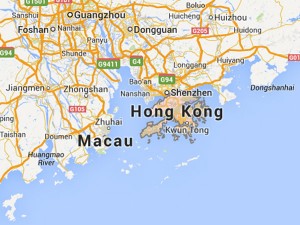
With the cost of high-quality raw jade and jade products surging repeatedly in the past eight years, prices tags are now becoming prohibitive and experts predict the bubble must soon burst as buyers are stepping back.
Driven up by the appetite of wealthy Chinese, the rising cost of jade is also being fuelled by fears of a shortage in supply from Myanmar, the key source.
“Consumers cannot accept the current high prices, therefore, no deal is reached,” Hong Kong jade dealer Li Kwong-kei told AFP at the Hong Kong Jewellery and Gem Fair Friday.
Li, who has participated in the fair for more than 10 years, said it was quieter than in 2011 and 2012.
“We are forced to raise prices – it is increasingly hard to get high-quality raw jade from Myanmar. If you do not pay more, the good raw materials will be owned by the others,” Li added, holding a green jadeite bangle with a price of HK$2 million (US$260,000).
“I have decided to wait for the prices of high- and mid-end jade to drop,” said Judy Chen, a Taiwanese buyer at the fair.
“It appears to me that their prices are kind of at the peak.”
Small businesses have also been affected – stallholders at Hong Kong’s famous outdoor jade market while away hours chatting with their neighbors, as customers remain sparse.
“I have seen some of my peers quit their businesses,” said 54-year-old stall owner Wong Fung-ying. “The prices are high while the market is quiet.”
Jade holds mythical properties in China, where it is believed to ward off evil spirits and bring better health.
With no international pricing system, values have been increasing since 2005 as the newly-rich in China have bought up jade products. Seen as a classier option than gold, it has become a status symbol.
Dealers are now worried that quality raw jade from Myanmar is dwindling as the country plans to process and sell its own jade products.
Myanmar keeps its cards close to its chest in a famously murky trade, and rumors are rife among dealers about its plans as the country opens up economically.
Jade dealer Liang Jianhui, based in southern China’s Guangdong province and one of 7,000 buyers at the gem auction in Myanmar’s capital Naypyidaw in June, told AFP that he could no longer afford to buy high-quality jade.
One bidder told AFP the auction had been less busy in the past two years than previously, with high prices putting dealers off.
“I set aside more than two million euros for the auction, only to find that I am too poor to win a bid for one single piece of top-end jade,” said Liang.
“If a piece of raw jade sold for 100,000 euros in the past, people would make an offer of 500,000 euros for the same one this year.”
One dealer said Chinese buyers had backed out of collecting their jade after having second thoughts about the high prices, while another said Chinese bidders had gone in high purposely to put the raw jade out of reach of their rivals.
Up to 90 percent of the world’s jadeite – the most sought-after type of jade – is mined in the northern Myanmar town of Hpakant and hundreds of tonnes are transported to state gem auctions, which have until now been held at least twice a year.
But in 2013 there was only one major auction, which saw the number of jade lots down by 38 percent compared with the previous auction in March 2012, according to local media quoting official figures, although it was still reported to have reaped $2.4 billion in sales.
“What they want now is not only to export raw materials, but also to process jade domestically and sell it to China,” said Li Lianju, a deputy director of Yunnan Land and Resource Department, who oversees the jade trade between Myanmar and China’s Yunnan province, a major commercial hub for the gemstone.
“The value of raw jade rises more than twentyfold after being carved and turned into rings, bangles or necklaces,” said Zu Engdong, head of Gemology at Kunming University of Science and Technology in Yunnan.
“So it makes full sense for the Myanmarese to process jade themselves.”
Some fear Myanmar will close the jade mines altogether or slow down production to protect jade sources. Fighting in Kachin state may also have affected jade mining.
What is certain is that prices for those buying raw high-grade jade are astronomical, trickling down to merchants who are upping prices to maintain their profit margin.
Yunnan’s Li says prices of lower-grade jade are already dipping.
“The bubble of low to middle end jade has burst first given the little fear of raw material shortage,” he said.
While prices of high-end jade are likely to jump after the raw material from the June auction is processed, Li predicts such surges cannot continue in the face of lack of trade.
“By the end of the year, the prices will start to drop from the sky,” Li said.

